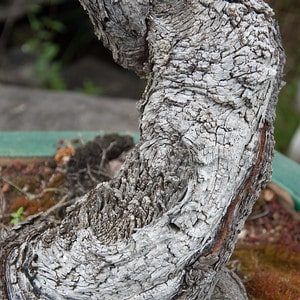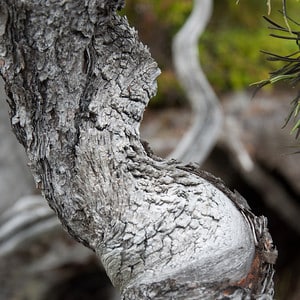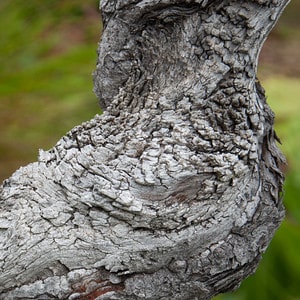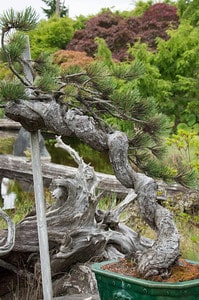For good reason, horticultural endeavors don’t often focus on death. Bonsai is an exception. Exposed deadwood on old trees can reveal hardship and character that defines a tree better than any other feature.
One of the best places to appreciate deadwood on bonsai is Elandan Gardens in Bremerton, Washington. Elandan is an amazing expression of Dan Robinson’s imagination – a bonsai museum and nursery on reclaimed land along the shores of Puget Sound. I think the best way to introduce the museum is by appreciating a great example of natural deadwood found on a Ponderosa pine whose character and age is well expressed in the scaly fissures of its weather-beaten trunk.

Ponderosa pine deadwood

Wonderful curves and scales and splinters

Unmistakable signs of age
The tree is over three feet tall – a winding specimen with sparse foliage atop curves that tighten as the trunk nears its apex.

Ponderosa pine at Elandan Gardens
As you can see by the setting, Robinson has created an environment for his trees that retains elements of the mountains from which these trees were collected. It’s a nice touch, and a great way to focus his visitors’ attention on the details in which he takes such great interest – the deadwood.
Subscribe to Bonsai Tonight
New Posts Delivered Every Tuesday and Friday
Greg Lagrange says
How prone is this deadwood to decay? How durable is it?
Jonas Dupuich says
Good question Greg, I’m curious myself.
mowerman says
It is about time someone gives credit to these great tree’s i have several collected ponderosa trees one is close to 1000 yrs (no kidding) or older depending if you go from larry jackels ponderosa book
EL TIM says
Is practically unknown in Europe this variety, this article takes us a little more to them.
Greetings from Spain
http://eltimbonsai.blogspot.com